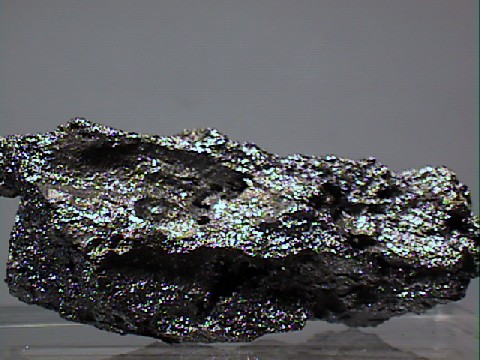 THE
MINERAL TITANIUM
THE
MINERAL TITANIUM
- Chemistry: Ti, Elemental Titanium
- Class: Elements
- Subclass: Native Metals
- Uses: A white pigment (as oxide), medical devices, jewelry, aerospace alloys and military armor.
Specimens
Native titanium rarely occurs naturally in its elemental form, even
though there are only six elements in the entire earth that are more abundant.
It has been found in extremely high
pressure metamorphic rocks and then only as
inclusions.
Titanium for industrial purposes is extracted primarily from
rutile,
ilmenite
and
Titanium was at one time a metal that had little use and basically no one knew what to do with it. Even as late as 1946 when the metal was finally shown to be capable of being produced commercially, it was considered a "laboratory curiosity". Since that time, titanium has been shown to be a strong aluminum-like metal; light weight, non-corrosive, able to withstand temperature extremes (especially its high melting point, 1800 degrees C) and it has good strength (as strong as steel and twice as strong as aluminum). Titanium alloys have found many applications in high tech airplanes, missiles, space vehicles and even in surgical implants.
Additionally, titanium dioxide TiO2, is a white pigment that is used more and more in paints as lead paint is discontinued due to health considerations. In fact, the largest percentage (up to 95%) of world wide use for titanium is for the production of this white pigment. The pigment has great luster, good endurance, high opacity (it hides whatever is under it, important for paint) and a pure white color. The pigment is also used to provide color for rubber, plastics, textiles, ink, cosmetics, leather, ceramics and paper. Titanium and titanium compounds have found uses in desalination plants, electrical components, glass products, artificial gemstones, jewelry and even as smoke screens. Ilmenite is mined in Australia, Brazil, Russia, Canada, Sri Lanka, Norway, China, South Africa, Thailand, India, Malaysia, Sierra Leone and the United States.
There are several common to relatively rare titanium minerals such as
rutile,
ilmenite,
sphene,
brookite,
anatase,
Titanium is three times stronger than steel, while weighing only 42% as much, making it an ideal strong, lightweight metal for structures such as airplanes and rockets. It is also chemically inert under normal conditions, enabling its use in medical implants such as pacemakers.
Titanium can be tarnished with heat or acids yielding uniquely colored, non-allergenic jewelry.
PHYSICAL CHARACTERISTICS:
- Color is silver-gray often with a multi-colored iridescent tarnish.
- Luster is metallic.
- Transparency: Crystals are opaque.
- Crystal System is hexagonal; 6/m 2/m 2/m. There is also an identified tetragonal variety.
- Crystal Habits are limited to microscopic inclusions.
- Cleavage is absent.
- Hardness 4
- Specific Gravity is 4.4 (light for metals).
- Streak is black.
- Associated Minerals include garnet and other ultrahigh pressure metamorphic minerals.
- Notable Occurrences are limited to microscopic inclusions in coesite eclogites at Dabieshan, China and at Kamchatka and Amur, Russia.
- Best Field Indicators: Rarity, color, luster and locality.



